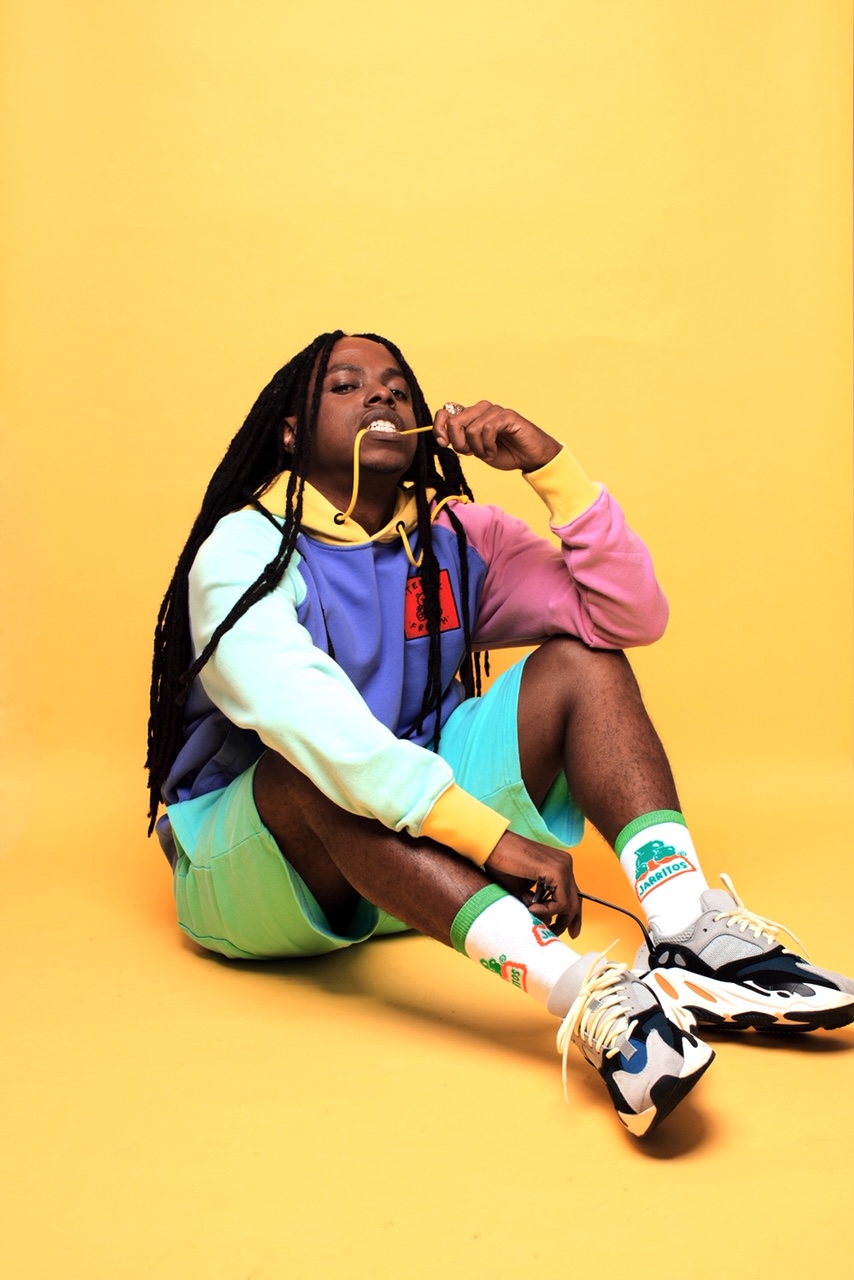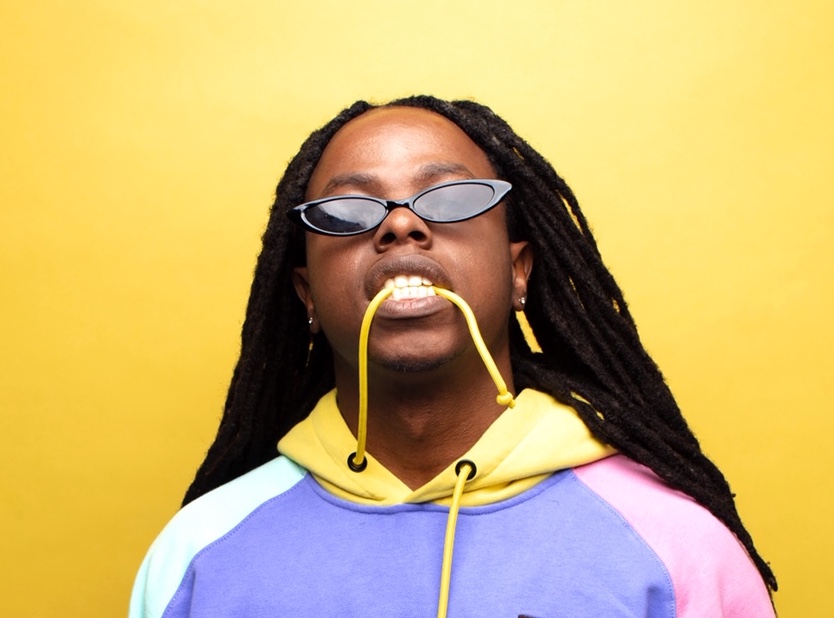Immediately warm and effusive, Joyce Santana’s charisma engulfs the world around him – a fact that’s noticeable even over the phone. A natural storyteller with an infectious and easy laughter, he lets out una carcajada when the inevitable question comes up: Quien carajo es Vicky?
If you look up “Quien carajo es Vicky?” on Twitter, you’ll find pages and pages of results. “It surprises me still,” he says, incredulous about the people-driven success of “Vicky,” a song about una niña de mami y papi who lowkey spends all her free time in drug-addled desastre y bellaqueo (si la vieran su mami su papi y sus titis / que la ven bien fina los domingo en Serafina / pa terminar siempre en cuatro en un motel en Carolina). “Vicky” came out in August, a late summer-into-fall bop that, despite no budget for promo, saturated the streets on the strength of its cutting bars, sick flow and sinister, minimalist beat (care of producer Hydra). “I didn’t expect the song to hit the streets like that.”
Joyce Fransue Santana Febres started making music as a kid of just eight. Raised by strict parents, he wasn’t allowed to curse. “[Those words] couldn’t leave my mouth,” he explains, so he would surreptitiously write them down on a piece of paper. Unfortunately for young Joyce, his mother found his naughty notes, but it was the sting of her punishment that provided the initial motivation to keep going. “I started writing down curse words,” he laughs, “and I ended up writing about what I was feeling.” At around thirteen, Santana got together with a group of friends to record his first song using the computer mic they had available, and an obsession began. “The first time I heard myself over a beat,” he says, pausing contemplatively, “…it drove me wild.” He was hooked. For a few years, Santana kept writing and recording songs until, for one reason or another, he stopped.
But Santana never quit writing, and even though his obsession with music never subsided, for a period he just focused on poetry. When a friend who made beats suggested he take his poems to the studio though, he was quickly reeled back in, and everything started to fall into place. It was around that time, he tells me, in 2011, that he started growing out his hair. One day when he was touching up his locs and texting a friend about the music he was working on at a friend’s house in Carolina, some guy walked in with a chip on his shoulder. Trying to calm him down, Joyce showed him some of his music; it stopped him straight in his tracks. “He left, and he came back with some beats,” Santana recounts. A few days later, he was in the studio with Young Martino – known now for producing ubiquitous mega-hit “Te Bote,” and to this day one of Santana’s most frequent collaborators. If you ask him, it wasn’t a coincidence. “That’s God,” he says, with unshakeable certainty. “Always putting you in the right place at the right time.”
In 2015 Santana released Luz En La Oscuridad, a vulnerable, meandering album that digs deep into his psyche. With dark bears and raw subject matter, it touched on matters of love, fear, relationships and loneliness. “There’s still people today that talk to me about [3:00 AM],” a track in which Santana raps about trying to find himself through the fog of depression. “[Luz en La Oscuridad] is the most me thing out there.” These days, Santana is feeling less like talking about himself, and rather than deep tracks that explore his emotional core, he’s after a more simple joy: making people dance. “It’s not that I’ve changed,” he explains. “I’m trying to step away from my comfort zone… Honestly it feels great.” Santana’s history as a true MC – as a lyricist, a rapper, an artist who has developed his flow – brings something special to these pari anthems. His bars hit hard and just right, and matched with the meticulous production Santana has an ear for working with – well, it’s just the needed touch to make you wanna romper esa cintura.
But just because the songs are danceable, doesn’t mean they lack depth. This summer, as Puerto Rico rose up to demand the ouster of Ricardo Roselló and the people protested with perreo combativo, Santana hopped on a track to support the anti-corruption protests and the perreo uprising. When the opportunity struck, Santana and a crew of young urbano artists on la isla decided to do a track sampling Puerto Rican newscaster Jorge Rivera Nieves’ now iconic clip reporting that “el perreo intenso acaba de comenzar.” They wanted to go for a vibe that felt like some of the super-group tracks of the old days – something à la “Llegamos A La Disco,” or “Yo Tengo Una Gata.” Soon enough the features rolled in – from Jowell y Randy, Brray and others – and Cauty put out “El Perreo Intenso,” which hit the streets and dancefloors across the island and quickly became viral. Santana’s verse was charged with both the bellaqueo and the political dissidence of the moment (Buena pero loca con eso’e portarse mal / la chala tirándole piedras a un estatal / el perreo está intenso en frente de la catedral / se fue Ricky Roselló cuando se van los demás), a perfect encapsulation of the indignation felt by Puerto Ricans and the joy with which they confronted it.

And though the emergence of perreo as a form of protest in the anti-corruption movement was controversial, with people on the island both praising and reproaching the perreo uprising, but Santana is clear and confident in his stance. “Perreo helped the world see what was happening here,” he assures. “It helped people rise up against what they needed to rise up against.”
Ask him about a new album, though, and he gets coy. “You know, we were just talking yesterday about something I’m not gonna tell you anything about,” he laughs. So he talks instead about his plans to do a trip around South America to work on new music, the “Vicky” remix he has in the works, and his plans for an upcoming Young Martino-produced track with Ñengo Flow, Eladio Carrion, Brray and Venezuelan newcomer Big Soto. Joyce Santana is grinding, easily among the best rappers on the island. It’s time the world took notice.







